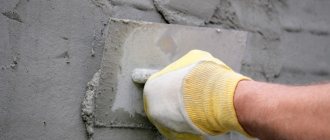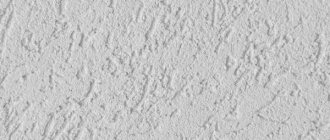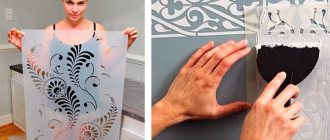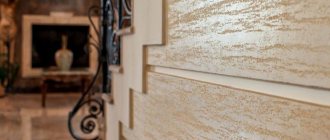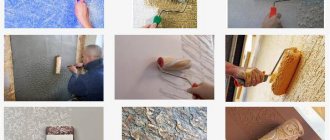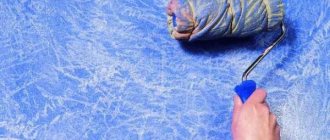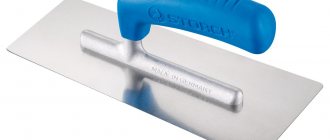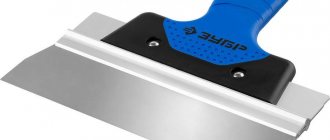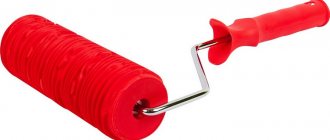Hands from the right place | 05/14/2016
The most common tools when carrying out construction, painting and other types of work are spatulas. The largest group among them are spatulas for puttying walls. They often differ in standard sizes and shapes necessary for specific work.
The optimal spatula for plastering walls
In modern life, during repair and construction work, various tools are used. This allows you to significantly simplify the procedure for performing certain actions. Of course, in such a situation it is impossible to do without a spatula for puttying finished walls. This treatment allows you to significantly increase the service life of such structures. Not everyone knows how to correctly select such accessories, which is why we need to consider in detail all the nuances of choosing these devices.
Spatula for puttying walls. What do you need to know?
The most common tools when carrying out construction, painting and other types of work are spatulas. The largest group among them are spatulas for puttying walls. They often differ in standard sizes and shapes necessary for specific work.
Types and sizes of spatulas for wall putty
Various tool options are used for plastering walls. In practice, this can significantly reduce time costs. Let's consider the main options for such accessories:
- Painting devices that are used to complete the finishing of structural elements.
- Facade spatulas, these varieties are used for processing external and internal surfaces.
- Corner options, which are used for more convenient application of putty inside or outside structures.
- Special elements for creating a structural surface, which are used to apply the finishing layer of plaster.
- Double-sided spatulas, which in practice are used to treat hard-to-reach areas.
- Among other things, this version of the tool varies significantly in size, which allows you to choose the optimal type for use in a given situation. Today, in order to significantly simplify the task of surface processing, tools are used where the working width varies from 10 to 60 centimeters. This allows you to optimally decide which spatula to choose for high-quality puttying of walls.
The devices differ not only in size, but also in the method of application. There are special products for leveling walls, professional elements, and also simple devices that even a person inexperienced in construction mechanics can handle. Of course, this entire distribution has a colossal difference in cost, which is why you should not have some difficulties in finding accessories.
Important! The choice should be made in favor of the option that fits best in the hand, this will eliminate unnecessary errors during the work process, which is why spatulas are available with a wooden, rubber, plastic or two-component handle.
Teeth size
How to choose a trowel for laying tiles, and what tooth size is best? The choice of tooth size depends on the size of the facing material.
Let's look at examples:
- 4x4 mm - used for facing products measuring 1x10 cm;
- 6x6 mm - used for finishing with standard dimensions of a facing product 15x15 cm or 20x20cm;
- 8x8 mm - for products 30x30 cm.
For large-format tiling structures, combs with teeth from 10 to 20 mm are used, for example, a trowel for floor tiles.
The shape of the comb teeth comes in three types:
- square;
- semicircular;
- triangular.
Criteria for choosing a quality spatula
If you need to choose the most suitable option for a tool, it is not enough to just answer the question of how to hold a spatula correctly; here you have to consider a number of criteria by which such accessories are selected, namely:
- first of all, you have to clarify the cost, since the cheapest accessories are unlikely to meet quality standards;
- you have to choose for yourself the best type of handle, which is easiest to hold in your hand, in order to avoid mistakes;
- it is recommended to take into account what type of work on the surface treatment of the structural element is being performed;
- it is important to take into account the scale of the actions being performed, and also the area of the wall that needs to be processed;
- among other things, you have to pay attention to the blade, which must be completely smooth and elastic.
Special interest will need to be shown in the material that was used in the production of the blade itself, as this has a direct impact on the subsequent durability of the device. Most often, blades for spatulas are made of stainless steel, which makes it quite easy to subsequently clean their surface from frozen excess material.
Choosing a tool for applying finishing putty
In order not to get completely confused in the presented options and to purchase a product that will perform the assigned tasks, we recommend that you pay attention to such characteristics. First of all, you should pay attention to the handle.
It should be comfortable, and it is better if there are no flaws or sharp protrusions on the surface of the metal. If they appear during the work process, this indicates that you are about to purchase a low-quality product.
Do not purchase items that are too long or narrow. They will be inconvenient to use during operation, while they are extremely difficult to operate.
To level the surface, it is more rational to purchase a product that is shaped like a trapezoid. Tools in the form of triangles or droplets are not so convenient.
Moreover, they performed poorly during operation. The blade of the working tool should be smooth, at the same time moderately flexible, and not deform with minimal pressure.
Ceramic brick is a material that has been successfully used in construction and renovation for a long time. Here are the pros and cons of this brick.
Putty can almost perfectly level the surface, as well as make it strong and durable. Here you will find out how long the putty takes to dry.
Crushed stone is mined by crushing rocks and metallurgical waste. By clicking on the link, you will become familiar with the characteristics of the flakiness of crushed stone.
If, while pressing on the blade, it begins to bend strongly during operation, the construction mixture will roll off such a spatula, and it will even be difficult to apply it to the wall, not to mention leveling it. Spatulas with excessive rigidity will undoubtedly become deformed during operation.
The correct spatula should be equipped with a blade that will spring slightly when pressed. To apply the finishing putty, you can use a tool whose blade is made of stainless steel.
This will make it easy to clean after work and will ensure there is no corrosion that will negatively affect the finish. A spatula with an iron blade and metal coating is considered a low-quality product and requires the utmost care to prevent the formation of rust.
It can negatively affect not only the material, but also the treated surface. Pay attention to the blade. There should be no sharpening points on it; it is rational to use such products for other types of work.
For more information about choosing a spatula, watch the video:
How to hold a spatula correctly when puttingtying walls
Please understand that there are some guidelines to follow when using this tool. This will eliminate certain errors and possible overconsumption of the mixture. Let's look at the basic rules:
- This element is held with a full hand to ensure ease of movement when applying putty to the wall surface.
- For ease of processing, a tool with a narrow blade should be held in the working hand, and a wide element in the opposite hand.
- When performing actions, you will have to bring the device at an angle so that its edges bend evenly.
- When performing work, the base layer is applied with a wide tool, and the excess material is moved to the middle with a narrow device.
- When grasping, you need to hold the canvas with your thumb on one side and four other limbs on the other.
- During work, it is necessary to gradually reduce the amount of deflection, reducing the pressure on the blade.
If you take all these recommendations into account, it is possible to correctly perform all the steps to treat the surface of a structural element. Of course, during the transition from the initial stage to the finishing stage, it is necessary to control the mass of the mixture used. This will not only eliminate its overconsumption, but will also limit the appearance of various influxes. It should be understood that in the initial stages, it is almost impossible to avoid sagging, which is why you have to arm yourself with two auxiliary tools at once in order to correctly and timely control the thickness of the plaster layer applied to the structural element.
Important! In order to avoid certain mistakes in the process of performing all the necessary actions, it is first recommended to look at a clear example, and in addition, try your hand at a certain prepared space.
In modern life, when carrying out construction and finishing work, it is customary to use various auxiliary accessories. This significantly saves time, and in addition makes the entire procedure much easier. It is quite difficult to imagine repair or construction without an ordinary spatula, since it is necessary for applying mixtures that extend the service life of certain structures. Working with these accessories is not as difficult as it might seem at first glance. It all depends on the correct choice, and also on the quality of the device itself. That is why, long before performing the appropriate actions, you have to seriously approach the process of selecting such elements. In such a situation, even a consultation with a specialist will not be a superfluous event.
Leveling the walls
It is very rare to have perfectly straight walls. Usually, some wall defects are hidden under wallpaper or decorative elements.
- Spatula for puttying walls: sizes and types of tools
Leveling the surface of the walls occurs in two stages:
- Application of the composition;
- Leveling.
Applying the base layer composition
If the house is new, sometimes slab joints and some unevenness in the plaster are visible on the walls.
Before applying the base layer of plaster, spot defects on the walls are removed.
Such manipulations will save time and well prepare the surface for further actions. To perform this work we will need a spatula with a narrow part.
The spatula can be made of either metal or rubber.
If possible, take two spatulas with different widths of the working surface, for example, from 20 to 50 mm.
Painting spatula
It is most convenient to scoop the putty out of the container with a narrow spatula .
Putty is taken in such quantities that it can be used to fill gaps, depressions or cracks in the wall.
- The best way to apply putty is with a spatula or trowel.
The composition is applied, as a rule, with a rubber spatula , since its working part is very plastic.
It is enough to make a few movements in order to fill the imperfections with putty and level the layer of putty with the surface of the wall. This spatula does not have a handle, which makes it easy to use.
A metal spatula is used to cover shallow crevices, cracks and joints.
- Use a spatula to scoop up a small amount of putty and then apply it to the area that needs to be putty.
- Then the mixture is distributed into the cracks so that it is level with the surface of the wall.
- The spatula is moved strictly in one direction. For example, from top to bottom or from right to left, the edge of the trowel should be almost parallel to the wall.
- Excess putty will need to be removed with a wide spatula after the gap or crack is hidden.
Leveling the composition
When all minor flaws have been eliminated, they begin to putty the walls.
It is necessary to putty carefully so that the surface becomes smooth, not rough.
The beautiful appearance of the finishing coating depends on the type of wall covering. After all, it is much easier to wallpaper a smooth wall than a wall with some roughness.
So, for work you will need a wide spatula with a working surface of 500-600 mm.
A wide spatula is very convenient to spread the putty over a large area.
You will also need a tool with a spatula , the width of which is 100-150 mm. It is needed to apply the solution onto a wide spatula.
- CASTING IN GYPSUM MOLDS
Methods for applying putty
Putty is applied in several ways:
- The putty is picked up with a narrow spatula and transferred to the surface of a wide spatula, then with its help the putty is applied to the surface of the walls;
- Take a narrow spatula and scoop up the putty with it and immediately apply it to the surface to be putty, then spread the entire mass over the wall with a wide spatula.
Tool characteristics
In appearance, a spatula is a spatula made of different materials, equipped with a handle. It is widely used for repair and construction work. With it you can:
- clean old putty, wallpaper and paint;
- apply cement, putty and other solutions;
- putty any surface;
- lay tiles;
- grout joints in brickwork or tiles.
The blade must be rigid and elastic, meet the requirements of the current state standard 10778−83. The tool has several important and standard sizes. In the first place is the width of the device, which, like other parameters, is selected according to the type of finishing work.
Manufacturers produce professional and non-professional models. Professional tools are distinguished by thick blades, they have a good service life, and they do not deform under load. Non-professional devices have a thinner blade complete with a plastic handle.
Related article: How to attach a countertop to a wall without support
For narrowly targeted finishing work, special devices are made.
Deciding on the type of tool
In modern construction, 4 types of spatulas are used:
- for painting work;
- rubber tools;
- notched spatulas;
- façade devices.
Each of the devices has its own positive aspects, which is important when carrying out finishing work.
Tool material
First of all, all construction spatulas differ in the types of materials from which they are made. They can be:
For the manufacture of rubber devices, oil- and petrol-resistant, high-density rubber is used. There should be no cavities, sagging, dents or bubbles on its surface. Bummer is also not allowed.
Steel is used in the production of metal spatulas. It must comply with GOST requirements. The tool with a stainless steel blade is considered to be the highest quality and most versatile. By spraying you can determine the quality of the metal. If the surface becomes dull, it is ordinary iron that is subject to deformation.
For plastic instruments, use high-density polyethylene, polypropylene or polyamide. It cannot be cracked, warped, pitted, chipped or silvered.
The spatula handle is made of hardwood lumber, plastic or plastic thermal rubber.
The tool is distinguished by the width of the blade:
- Wide. Blade length ranges from 150mm to 400mm. Used to eliminate uneven surfaces and curvatures. It is convenient for her to level the applied putty.
- Average. The length of the plane is 100−150 mm. The main task of such a tool is to seal holes. It makes it possible to ensure that the top layer of the material is smooth.
- Narrow. Blade length minimum 20 mm up to maximum 100 mm. This type of device is used to fill small defects that may remain after a medium spatula. It will not be able to level the surface, but it is convenient to take the solution from the container and apply it to the surface with a working spatula.
The selection of tools for finishing work will depend on their type and skills of the performer.
How to choose
When choosing a tool, three main criteria are taken into account:
- Plate shape and size.
- Plate material.
- Handle characteristics.
Blade shape and size
Based on the shape of the plate, spatulas are divided into the following categories:
- Straight . The straight edge of the working part is considered the most common due to its versatility. There are models with blades from 2.5 to 25 centimeters. The straight shape is suitable for applying compounds and leveling them.
- Pointed . The sharpened edges are designed to work in hard-to-reach areas. They are used for filling small defects and performing small jobs (such as puttying wooden frames). The width of the plate ranges from 2 to 5 centimeters.
- Serrated . The plates are created to level out adhesive compounds before laying tiles. The teeth evenly distribute even those compounds that differ in their viscosity. The width of the blades reaches 30 centimeters - for working with large areas.
Blade material
Different types of work require blades of varying degrees of flexibility and thickness. The main materials from which the plates are made include:
- Stainless steel . Durable material that is not subject to corrosion. Does not sag under construction mixtures and is not subject to breakage. Spatulas with steel blades are used for working with tile adhesive, removing wallpaper and paint. They are durable.
- Rubber . Rubber blades are used at the finishing stages of finishing. These include applying decorative plaster, grouting the seams of facing tiles and distributing putty along curved areas.
- Plastic . Plastic plates are suitable for final leveling of medium-thick putty. They are also useful when wallpapering - as an aid. This material gently removes air bubbles and excess glue from under the canvas.
What material is the blade of your spatula made of?
SteelRubber
Handle characteristics
The quality of the handle affects the speed of work and its quality. The ease with which the master uses the tool depends on the ergonomics of the handle.
There are three types of handles for spatulas:
- Wooden . Lightweight and durable material, which is often found in budget models. The only drawback of wood is cracking - in case of improper processing.
- Plastic . The quality of plastic handles varies depending on the manufacturer. There are ergonomic and durable options, and there are unreliable and fragile ones.
- Two-component . The handles combine two materials: plastic and rubber/silicone. Rubber inserts are located in places of contact with the palms and fingers. These handles are not subject to rotting or corrosion.
Expert opinion
Torsunov Pavel Maksimovich
Some models of spatulas do not have a handle at all. These include Japanese rubber spatulas. Instead of a handle, there is a compact holder at the base of the tool.
Choice depending on the type of work
They select devices according to the type of work, since at each stage different types of spatulas are needed:
- Facade . They are used to apply the solution to a large surface area with subsequent leveling. The tools are highly durable. The blade is made of anodized steel alloys, so it has high rigidity. The level of durability and reliability is increased by the aluminum body in which the blade is fixed. The handle in the device is usually plastic thermorubber, and the blade has a wide blade.
- Painting. These instruments are distinguished by their thin blade. They are more springy and flexible, unlike façade spatulas, so they are not only convenient for applying mixtures, but also easy to remove old paint or wallpaper. The main area of application of these devices is finishing work. They first apply and then level the putty, carry out minor repairs, and seal cracks. The size of the canvas can be narrow, medium or wide. The handle of the tool is made of rubber or wood.
- Serrated. These are special-purpose devices that can provide a strong grip. They are used for applying glue to different surfaces. The purpose of the teeth on the blade is to evenly distribute the adhesive composition over the surface and remove excess mixture. The depth of the teeth and the size of the blade are selected individually depending on the material and type of surface.
- Angular _ The tools are narrowly focused and are used to align external and internal corners. Two tool blades, which are made of stainless steel, are connected at right angles to each other. In order to use this device at work you need to have certain skills.
- Rubber. The devices are made in different sizes and shapes, with durable and elastic types of rubber. The blade of the spatulas is thin and flexible without joints or joints. They are convenient for rubbing seams, dents on walls or repairing scratches. The width of the tool blade varies from 40 mm to 200 mm. They are sold in sets with the most popular sizes. The handle is made of rubber or wood.
- Plastic . The tools are used when smoothing self-adhesive film and wallpaper. They cover a large area and fit tightly to the wall. They are made of elastic and durable plastic, with or without handles, in various shapes.
- Scraper . These devices are designed to remove excess mortar from the treated surface, excess paint, putty from the roller or glue. Using the pointed tip of the tool, you can open cracks in the wall for their further restoration, and use the oval hole in the canvas to remove nails. The width of the blade is narrow, it is made of durable metal, which gives it rigidity.
A number of non-standard spatulas are used in decorative plaster. These include the Venetian relief spatula - trowel. It has four working edges, which are convenient for making patterns and applying decorative plaster. Another type of device is a stainless steel spatula with a blade, polished on both sides. Its purpose is similar to paint spatulas.
Kinds
Depending on the type of work for which the spatula is intended, this tool is divided into several types:
- Painting.
- Facade.
- Serrated.
- Rubber.
Painting
Painting spatulas are intended for puttying surfaces indoors. Instruments of this type have a trapezoidal shape. They are equipped with a handle that is made at an angle. The material used for the handle is plastic or wood. The plate is usually created from stainless steel.
The jobs for which paint spatulas are used include the following:
- Sealing cracks.
- Surface treatment.
- Giving a special shape to walls or ceilings.
- Filling holes and potholes.
Tools in this group are not intended for working with heavy mixtures. They also cannot withstand collisions with an abrasive surface. The blades are distinguished by their elasticity, but due to their thinness they have increased fragility. The material that paint spatulas are suitable for working with is plaster.
Facade
Facade spatulas are used for both interior and exterior decoration. Their blades are more durable - compared to paint models. The plates are made of high-strength steel, which allows them to be used when working with mixtures with aggressive substances. Facade spatulas are equipped with wide blades for processing large areas. The standard width is from 300 to 600 millimeters.
Facade spatulas perform several main functions:
- Plaster distribution.
- Puttying of vertical and horizontal surfaces.
- Coating various walls with compounds containing heavy mixtures.
Expert opinion
Torsunov Pavel Maksimovich
When choosing a tool, it is important to consider the area on which the work will be performed. Too wide or too narrow can become an obstacle to quality putty. Models whose blades are more than 400 millimeters wide belong to the professional line.
Serrated
A notched trowel is a tool that specializes in distributing adhesives over a tile surface. It is also suitable for working with textured plaster.
The inserts are suitable for processing the following materials:
- Decorative rock.
- Tile.
- Mosaic.
- Porcelain tiles.
- Aerated concrete.
- Styrofoam.
Dental spatulas differ from each other in the width of the plate and the width of the teeth.
The parameters affect what material a particular model works with:
- Teeth 6x6 mm are used for laying tiles 200x200 mm.
- Teeth 8x8 mm are used to work with tiles 300x300 mm.
- 10x10 mm teeth are suitable for laying 300x300 mm tiles with a thickness of 10 mm or more.
Also, the size of the teeth affects the thickness of the adhesive layer. An increase in the teeth leads to a proportional increase in the layer. The most popular models have a tooth height of 6 to 8 millimeters.
Rubber
Rubber spatulas are also divided into groups - soft rubber, painting and grouting. Soft rubber specimens are used for smoothing wallpaper and sealing seams. Painting models are optimal for distributing grout, mastic, thick glue and putty. Grout models are regularly used for grouting joints on linoleum and ceramic tiles.
The class of rubber spatulas is rarely used for putty work. It is also not suitable for grouting stone tile joints. The narrow application of these instruments is due to the soft plate. If handled incorrectly, the material loses its integrity and its further use becomes impossible.
Rubber spatulas have the following advantages:
- A soft effect on the surface that does not leave scratches.
- Rubber easily adapts to the surface and follows its contours.
- A variety of plate shapes - there are rectangles, trapezoids, wedges.
Criteria for a quality spatula
Today, construction stores have a large assortment of spatulas, which creates certain difficulties for the buyer. Therefore, when choosing a tool you need to pay attention to some features:
- There should be no burrs or nicks on the surface of the handle; it should fit comfortably in the hand. The presence of any defects indicates the low quality of the instrument.
- The tool should not be too long or narrow, because it will be difficult and inconvenient to operate while working.
- It is better to putty with a trapezoidal spatula; drop-shaped or triangular tools are not suitable for this type of facing work.
- The tool blade must not only be smooth, but also have sufficient flexibility. Rigid ones can break during operation, and the mixture will fall from blades that are too flexible. The blade should spring back when pressed.
- For puttying walls, it is better to use a stainless steel sheet. It is easy to clean after use.
- The blade of the putty tool must not be sharpened.
A good tool is a professional tool. It is better to opt for it, since non-professional models will have to be changed often.
To putty the walls, you need to choose a combination of spatulas. It consists of a main tool with a blade width of 200−250 mm and an auxiliary tool with a blade width of 80 mm to 100 mm.
Selecting a spatula by size
Spatulas may differ in quality, price and material. Professional tools are more expensive, but they will “survive” more than one repair. Cheaper and simpler products should be handled with care.
When choosing a tool, you should pay attention not only to its cost, but also to its size, namely, the width of the working surface. An incorrectly sized spatula will bend and eventually simply break, and the work itself will be performed poorly.
Experts recommend buying a facade or painting spatula with a working blade width of 300-400 mm. But here too it is worth considering the surface area. If you need to apply rough putty, you will need a model with a narrower blade, and for sealing cracks and for areas with corners - a very small one.
Note! If the surface has deep holes, then a large tool is needed to eliminate defects and apply a large layer of material.
Trusted manufacturers
German is known to Russian consumers as a seller of repair products such as rollers, brushes, glue guns, paint containers and spatulas. This entire tool has proven itself to be unpretentious and reliable among professional builders. Biber spatulas are produced for different types of work and are made of various materials - stainless steel, plastic and polyvinyl chloride, with wooden and plastic handles.
The FIT-Tool company is an official dealer of the Canadian company, producing electric and hand tools for household and professional use. It has a large network of branches throughout Russia. One of the niches in hand tools for every day is occupied by painting and plastering and finishing models. The advantage of FIT spatulas is their affordable price, quality, ergonomics and variety of models and types.
Today the Russian market is developing dynamically. It specializes in the production and sale of hand-held construction tools. The company is constantly increasing the output of finished products and assortment, and regularly modernizes production. High-quality raw materials are used in the manufacture of spatulas. The combination of price and quality makes them affordable for consumers and makes them in demand for professionals.
Related article: Is it possible to hide polypropylene pipes in the wall
A participant in the global market for quality goods is the well-known Russian one. The company regularly increases its range and improves its finished products. It has its own testing laboratory where, before reaching consumers' shelves, products undergo multiple tests. Spatulas from this company are presented in two-component and plastic variations. A quality service created specifically for this purpose is responsible for their quality.
This is not the entire list of manufacturers of quality spatulas in the middle and budget price categories.
Main manufacturers
You can purchase a spatula from different manufacturers, but the following European brands are in greatest demand:
Among domestic manufacturers, the Zubr trademark has proven itself well. All of these manufacturers produce high quality tools and provide a guarantee on their products.
Today, the market offers a wide range of spatulas for puttying walls, and each person decides which tool to choose individually. You should not buy an unknown model at a low price, since the quality of the tool will determine how durable the repair will be.
Source
Getting to know the tool
Each of us is familiar with the spatula, because its scope of use is not limited to putty. The tool is used to spread and smooth the construction mixture on the surface, remove old paint if you need to remove wallpaper. Spatulas are used when laying tiles and grouting joints between them, laying bricks or cinder blocks; in addition, they are used to identify small defects in walls. The classification of construction tools is carried out not only according to its purpose, but also according to the material of its manufacture. Spatula for puttying walls for professional and non-professional purposes are divided into the following:
Important! In order to do the job professionally, you need to use the right spatula. The peculiarity of most tools is that they can be used not for their intended purpose, but for a wide range of actions.
Choosing a staple in a store (video)
Puttying surfaces is carried out using a variety of blades, which differ in their purpose:
- Painting – necessary for high-quality finishing. It is easy to work with, and in appearance it resembles a trapezoid with a plastic handle. The spatula is used in the process of leveling the surface after applying putty, when you need to repair a crack or dent in the wall or mask the seam between gypsum board slabs. If you need to putty a structure with a complex shape, then a paint spatula will become an indispensable assistant. Among the advantages of the tool are a flexible but elastic blade and a thin plate. Manufacturing material – stainless steel.
- Facade - the peculiarity is that it is used for both external and internal work. The shape resembles a trapezoid, while the width varies from thirty to sixty centimeters. Carbon steel is used as a material for the blade - it has increased strength and resistance to bending. Using a wooden or plastic handle, you can apply the mixture to large surfaces.
Putty spatula
- Corner - the name speaks for itself. A very necessary and convenient spatula when you need to putty corners inside or outside the house. In its original form, the tool creates an angle of 90 degrees
Important! Many people are interested in which spatula is best for puttying walls? It is necessary to choose the type and size based on future processes, and it is better to abandon aluminum tools. They are short-lived and require additional care.
Rating
There are both Russian and foreign manufacturers on the spatula market. New models appear constantly, but their structure largely remains the same.
Among the popular companies that produce spatulas are:
- Stayer.
- Cedar Pro.
- Santool.
- Hammer.
- Inforce, etc.
STAYER MASTER 10041-10
STAYER MASTER 10041-10 is equipped with a blade 100 millimeters wide. The blade is made of stainless steel, which increases the service life of the tool. There are no teeth on the blade, which ensures smooth sliding of the spatula over the surface. The two-component handle fits comfortably in the hand while working. The weight of the model is 100 grams.
Valery
Spatel bought it to replace an ancient Soviet model that had become rusty. They are comfortable to work with - the hard blade is easy to clean and does not deform.
Alexey
Instrument does an excellent job with his direct task - putty and plaster. Does not get stuck in the material and washes well.
TOPEX 18B604
TOPEX 18B604 is designed for distributing construction mixtures and cleaning dirty surfaces. All TOPEX products are manufactured in Poland. The tool includes two parts - a stainless steel blade and a two-component handle with an anti-slip coating. The blade width is 40 millimeters. The weight of the model is 90 grams.
Ivan
Spatel is comfortable to hold even without gloves, which happens quite rarely. Forward and reverse grips are equally good. I bought a tool for the brigade and did not regret it.
Nikolay
I bought a spatula for home repairs. The tool is ideal for small jobs. The metal plate is not scratched or stuck.
Top Tools 18B303
Top Tools 18B303 is used for repair and finishing work. It is used in the process of applying gypsum mortar or cleaning surfaces. The tool is equipped with a 30mm blade. The handle is made of wood and the blade is made of metal. The homeland of the brand is Poland, but the products themselves are manufactured in China. The weight of the model is 30 grams.
Pavel
was looking for the most inexpensive spatula for filling the heads of self-tapping screws in drywall and settled on Top Tools. The putty consumption with this tool was moderate, which was important for me.
Denis
Spatula is well suited for driving putty into seams. Due to its small size, it fits into any gap without any extra effort.
SANTOOL 60 mm
SANTOOL 60 mm is designed for applying, leveling and smoothing putty layers. The handle of the tool is made of wood and fits comfortably in the hand due to its ergonomic shape. The varnish coating gives it a smooth finish. The width of the toothless blade is 60 millimeters. The blade is made of steel and is not subject to rust. The weight of the model is 40 grams.
Konstantin
It is convenient to work with a spatula - the blade does not bend under pressure, and the tool itself does not play in the hand. I came across this manufacturer by accident and am completely pleased with the result.
Alexander
I bought a spatula for less than 100 rubles and did not expect much from it. The advantage is the stainless steel fabric. I couldn’t make friends with the tool’s handle—it kept slipping.
FIT 06687
FIT 06687 was developed for applying mortars, sealing seams and cracks. The 125mm stainless steel blade easily distributes any material without getting bogged down. The handle is covered with rubber to prevent slipping in the hand. The two-component handle material allows you to use the tool for a long time. The weight of the model is 120 grams.
Vasily
Inexpensive spatula with average strength. Suitable for home work, but nothing more. An uneven work surface may leave marks.
Vitaly
Spatel is easy to use and does not raise any complaints regarding the quality of work. The only problem with the tool is that it is difficult to wash the handle. In the end there are still stains on it.
HAMMER 238-012
The Hammer Flex 238-012 notched trowel is used for distributing adhesives during the installation of tiles, porcelain tiles and facing stones. The blade is made of spring steel with anti-corrosion coating. The width of the blade is 150 millimeters. The size of the tool tooth is 6x6 millimeters. The handle is made of plastic, painted black. The weight of the model is 100 grams.
Arseny
Thanks to the wide base, the spatula holds a lot of solution. During operation, the surface does not bend.
Vladimir
The smooth, even canvas distributes the glue well. The only thing that bothered me was the presence of dents on the handle. Because of them, the tool is not very convenient to work with.
Inforce 020605-080-300
The Inforce 020605-080-300 notched trowel is used when laying tiles - to distribute and level the working mixture. The 300mm blade is made from cold-worked stainless steel for long-lasting use. The size of the teeth is 10x10 millimeters. The ergonomic plastic handle fits comfortably in the hand and lightens the weight of the tool. The weight of the model is 17 grams.
Mikhail
Despite the low price, the spatula performs well in use. The steel does not bend, the teeth are sharp and do not become dull after a couple of uses.
Vadim
took a spatula to lay floor tiles. The tool was worth the expense - with its help I was able to lay 20 square meters of porcelain stoneware.
Each spatula is designed for a specific type of work. The tool is selected based on several parameters. The surface area, the material being processed and the tasks are taken into account. When buying a spatula, the master pays attention to the shape of the plate, the materials from which it is made and the shape of the handle.
Varieties of narrow uses
There are spatulas aimed at a narrow range of uses. This is their advantage, because the tools make it possible to save consumables and create drawings and patterns on the walls. The scraper spatula has a flexible blade that makes it possible to remove excess material from the surface to be finished. Rubber elements are used for sealants and tile joints.
Curly ones allow you to create designs and patterns with decorative plasters on the base, and jagged ones are used for applying adhesive mortar. It should be noted that notched spatulas differ in their width, which is 100, 200, 300 mm and they can only be used on flat surfaces. Spatula for puttying walls with characteristics for choosing by size:
| Size: | Description: |
| Up to 60 cm | To work, you need to have a rule. Allows you to eliminate wall unevenness. Used for large-scale processes of roughing and starting work. Wide tool is easy to use |
| Up to 25 cm | They help putty small flaws, potholes, cracks and partitions. Subsequent processing will require sanding of the base. |
| Up to 10 cm | Widely used for hard-to-reach places, well suited for niches, slopes, arched areas |
To make choosing a spatula a little easier, pay attention to the table. Before buying a tool, check the blade for geometry and the handle for strength:
| The producer, d*sh | Price | |
| Anza | Rubber handle, 4.8cm*20cm | 1100 rub. |
| Wooden handle, 20*20 cm | 450 rub. | |
| Plastic handle, 20*20 cm | 930 rub. | |
| Kraftul | Wooden, 400mm | 650 rub. |
| Rubber+plastic, 450mm | 630 rub. | |
| Bison (Zubr) | Two-piece, 600mm | 410 rub. |
| Two-piece, 470mm | 350 rub. | |
| Two-piece, 350mm | 290 rub. | |
Important! A good manufacturer always gives a guarantee for their product.
Among the names of construction tools, there are often those that we use in everyday life. For example, a trowel for working with putty is a trowel that has a long and narrow shape, used for smoothing large areas. In the photo and video lesson, professionals tell you how to work correctly with large spatulas and how to hold the spatulas correctly when plastering walls.
Often, when applying starting plaster to walls, stripes remain; if they are insignificant, then there is no need to worry. All stripes come off perfectly under the finishing solution. In addition, you should not mix the solution for a long time, otherwise dry particles will appear in the mixture and when working with a spatula, they will appear on the walls in the form of scratches. If you choose the right trowel and carry out all the plastering work according to the technology, the coating will last for many years.
Serrated
When laying tiles and stone tiles, a notched trowel, also known as a comb, is often used to apply the adhesive. A distinctive feature of the tool is the teeth located on the edge of its blade. It turns out that the glue is laid on the wall in grooves.
Advantages of the method:
- High performance. With this method of application, the solution is evenly distributed under the tile, filling the voids. As a result, the master does not have to waste time squeezing out and removing excess.
- Quality of tiles. The tile lays flatter than when applying glue with a regular sheet due to its more even distribution under its surface. The necessary strength of the connection is also ensured.
- Saving. Helps avoid overuse of glue, reducing financial costs.
Other areas of application of a notched trowel: creating textured decorative plaster, laying parquet, applying glue to insulation.
Textured decorative waves from the teeth of the tool.
Expert opinion
Sergei Shablovsky
Plasterer
Tip: The thickness of the applied adhesive solution can be changed by increasing or decreasing the angle of inclination of the spatula to the surface to be treated.
Varieties
Tools for puttying surfaces vary in shape and standard sizes, which are necessary for specific work.
Painting spatula
The trapezoidal product has a steel plate 0.5-1 mm thick, which has sufficient rigidity and bends well. The tool has a plastic handle and a minimum blade width of 2 cm. It is intended for the following work:
- marking seams between plasterboard sheets;
- puttying of surfaces and complex structures;
- sealing any cracks and cracks;
- leveling surfaces after applying putty.
Construction stores sell disposable household painting products with a working surface of 0.5 mm. It bends easily, so it is difficult to obtain a smooth surface with its help. Therefore, professionals choose high-quality steel spatulas with a thicker blade.
Tools for facade work
Special spatulas are used for puttying and leveling surfaces that have a large area. They are made of durable steel and have a wide working trapezoidal plate with a width of 30 to 60 cm. Using a rigid, durable and wide blade, the solution is applied immediately to a large area of the surface. For ease of use, the handle is made of two-component plastic rubber.
During finishing work, facade and painting spatulas are used together. It is convenient to apply the solution with façade tools, and to distribute it over the wall or ceiling with painting tools.
Spatula-scraper
To remove excess hardened putty, use a special tool in the form of a scraper. It is distinguished by a rigid, thick blade made of especially durable metal, the width of which can be from five to seven centimeters.
Corner putty tool
To obtain an even internal angle between wall joints and between wall and floor, corner spatulas . The tool consists of two surfaces located at right angles to each other. It is quite difficult to use, which is why such spatulas are used mainly by professional builders.
In addition to those described above, there are types of spatulas that are designed for specific jobs:
- Figured products are used for applying decorative plaster and liquid wallpaper. With their help, they give the walls a certain texture. Curly instruments are made from plastic.
- Rubber spatulas have a working surface from 40 to 80 cm and are used for puttying small surfaces and processing tile joints. Products with a rubber base are convenient for applying sealant.
- Notched trowels are used to apply construction adhesive. The teeth on a tool can be of different widths and shapes. To apply liquid glue, you should choose a product with small triangular teeth. Products with large teeth are ideal for working with gypsum glue. It is recommended to use a notched trowel only on flat surfaces.
Facade models
When it is necessary to work with heavy mixtures, facade devices are usually chosen because of their reliability. Compared to other types of spatulas, these devices are distinguished by their large size and the ability to finish large surface areas.
To buy a spatula, you can decide on the required model by looking at the photo. Particular attention should be paid to the quality of the material and the cost of the device. If you pay attention to the purchase of the device, the work process will be a pleasure.
You must be prepared for construction work in advance, and as a result it is very important that the façade , painting
or other types of tools were purchased in advance.
And, by the way, the types of spatulas can be different, and as a result it is necessary to remember which of them are used for what.
How to choose a spatula?
Many people are sure that there is only one type of spatulas, but they are deeply surprised when they come to the store. In order not to make a mistake, you need to remember what spatulas are and what they are used for. The selection primarily depends on the type of work being performed, but there are several tips that must be followed. For example, it is very important to check how firmly the handle and the plate are connected; there should not be any difficulties, otherwise the tool will simply break during the working period.
Spatulas must be elastic and resilient, which is necessary so that you can easily apply the mixture to the surface for work. Moreover, it is necessary to pay direct attention to what the plate itself is made of: it can be either plastic, or metal, or rubber, and if you buy it from metal, then take only stainless steel.
Moreover, you should make sure that the paint spatula
for the ceiling surface or for the walls was very smooth, without notches, otherwise it will leave streaks during the working period. And remember, the speed and quality of work will also depend on whether you feel comfortable holding it in your hand.
Read also: Graphite crucible for induction furnace
Selecting a spatula for putty and other work
The video shows an angle spatula
- Painting tool
or
spatula
for sealant.
It is sometimes used as a tool for structural plastering. To put it another way, using its help you will smooth out unevenness after putty or plaster. Such a tool has the usual trapezoid shape, with a comfortable plastic handle, and its working surface is made of high quality stainless steel. One of the very popular sizes is from 20 to 25 centimeters. In this case, it is better to purchase two of them: a key spatula and a spare one. - Angular. It is intended for finishing finishing specifically in the corners of rooms, since the work here is quite difficult, requiring a special tool.
- Facade
.
If we talk about the name, it becomes clear that using its help in most cases they carry out work on external surfaces. The only difference is that in this version a harder and “rigid” material is used, and as a result of this, the spatula
must be of appropriate quality. - Scraper. Intended for removing outdated wallpaper, paint, plaster or putty. It cannot be used for final finishing. Its blade is thicker than a painter’s blade, it does not bend. Not a single preparatory work can be done without it.
- Plastic ( linoleum spatula You can also straighten wallpaper where it cannot be done with a roller.
- Serrated. Used for applying adhesive to tiles. It must be selected naturally with the composition of the solution. So, if, for example, a spatula with small teeth, it can be used for gluing carpet or other floor covering, with large teeth - for applying, for example, glue based on gypsum or other material of similar consistency. However, it is appropriate to note the following here - you must use it only on smooth surfaces, otherwise the application of the solution will be carried out with errors, which may later lead to a quick re-repair.
- Rubber spatula for silicone. It is needed in case there is work to be done on grouting joints or removing excess mortar from the work surface.
- The spatula for seamless ceilings has an oval blade shape and a curved handle for comfortable operation. It is necessary for securing the harpoons of a seamless ceiling. It is worth choosing it very carefully - sometimes it is worth sanding the wooden handles with sandpaper, because... When stretching the ceiling, you have to hold the spatula especially tightly in your hand, and if the handle is poorly executed, you can injure your fingers.
As you can see, a trowel is a key tool in any construction job. And therefore, you do not need to save on purchasing it, because the cleaning of the surfaces and the application of finishing material to them depends on what tool you purchase. If problems arise, always take an interest and ask questions of professionals.
Criterias of choice
Construction stores offer a large selection of spatulas , among which you need to choose a convenient and high-quality tool for yourself. To do this, you need to listen to the recommendations of professionals:
- For starting work, products with an iron or steel blade are best suited. To prevent the working surface from rusting, its surface must be coated with a special coating. After use, wipe the blade thoroughly and dry it. This product should be stored in a dry place.
- For finishing work, a blade made of stainless steel is selected. If it is made of a different material, marks may remain on the walls.
- Painting and façade tools must have an elastic blade. It should not be too rigid and at the same time should not bend from the slightest impact on it. It is inconvenient to apply the solution with a hard blade, and the mixture will simply fall off from a soft cloth.
- In construction stores you can see drop-shaped, trapezoidal and triangular products. The most reliable and easy to use blades are in the form of a trapezoid.
- On sale you can see spatulas of various sizes. They can be short or long. Experts recommend choosing medium-sized blades that are most comfortable to work with.
- To apply putty to the walls, use an unsharpened cloth. The sharpened blade is designed for applying adhesive to the tiles.
- The spatula must be carefully inspected. There should be no jagged marks on it, and the blade should be perfectly straight.
Having chosen a tool suitable for the job, you need to hold it in your hands. If holding it is uncomfortable, then you should refuse to purchase it.
Main manufacturers
Nowadays there are many manufacturers of painting tools on the market. The most popular tools are from European brands “Matrix”, “Santool”, “Homa” and “Eurotex”. Among Russian manufacturers, according to user reviews, the tool of the Zubr brand has proven itself well. All of the above manufacturers provide a guarantee for all products, which indicates high technical quality and reliability in working with the tool.
In order for the spatula to serve for a long time, regardless of its manufacturer, do not forget to thoroughly rinse the tool from plaster or other materials after carrying out work.
Source
Selecting Tool Size
During construction work, a spatula alone is not enough. At different stages you will need tools that differ in size and shape.
Wide tools with a thick plate are necessary for starting work. With their help, uneven surfaces are eliminated, cracks , crevices and deep damage are sealed. Using a large blade up to sixty centimeters wide, the solution is applied in a thick layer and distributed over the surface.
Products with a plate up to twenty-five centimeters wide give surfaces smoothness and remove holes. They are used after the walls are leveled. After using medium-sized tools, ridges may remain, so sanding is necessary.
Spatulas with narrow blades are designed for filling small flaws on walls. With their help, the mixture is applied to hard-to-reach places where it is inconvenient to work with a wide tool. Narrow blades are also used as an auxiliary tool, which is used to remove excess solution from a wide plate.
Selection of gear attachments
Using this type of spatula, you can apply the adhesive composition when carrying out facing work. It helps to reach the most difficult to reach places, including applying glue under natural and artificial stone, ceramic tiles and other materials.
Usually choose an option with teeth from 6 to 8 mm.
Correct Application
Regardless of whether wallpaper, paint or decorative plaster is applied to the walls, at the first stage the surfaces should be leveled and all cracks should be removed. After this, the walls are plastered and degreased.
The next stage is priming the surfaces . When the walls are dry, you can apply the starting putty. During such work, it is necessary to use a spatula correctly. The primer solution is prepared from a dry mixture and water. You should get a homogeneous consistency, for which it is recommended to use a construction mixer. The prepared solution is taken from the container with a small spatula and applied to a wide one. The mixture is applied to the surface at an angle of 45 degrees. As soon as the excess solution on the large instrument begins to dry out, it is removed with a narrow blade. Otherwise, scratches will remain on the walls.
After the putty has dried, the surfaces are primed again and covered with paint, wallpaper or plaster. If decorative plaster is to be applied, then curly tools are used to obtain the desired effect.
Painting variety
The product of this group has the following characteristics due to which they are selected:
- purpose – applying putty to the surface;
- blade elasticity;
- thinness of the blades;
- economic benefit of price.
If you choose a spatula for applying heavy mixtures and performing operations with a large load, it is worth purchasing devices of other varieties.
Recommendations from experts
- For surfaces with a large area, it is better to use large tools, otherwise the mixtures will dry out during work.
- For puttying walls, it is recommended to purchase dry mixtures , as they are of better quality than usual.
- Before applying putty, all cracks and crevices . This procedure will help avoid destruction of the walls.
- All surfaces should first be cleaned of dust, old paint, and wallpaper. Only after this can the plaster be applied.
- To speed up the finishing process, it is recommended to work with two spatulas.
- For putty, you should choose only high-quality mixtures that are diluted strictly according to the instructions.
- All work must be carried out wearing a respirator.
- After use, instruments must be cleaned of any remaining solution, washed and wiped.
The final result of the repair depends on the quality of the work and the correctly selected tools. Therefore, special attention should be paid to the choice of spatulas for puttying walls, which must have the appropriate size, shape, quality and convenience.
Spatula for leveling walls. Leveling walls with putty
This method is not technically complicated, but requires direct execution skills, especially over large areas.
Leveling is carried out using spatulas, the width of which depends on the stage of work and the size of the defect. Typically, a painter works with two spatulas at the same time - one takes the mixture from a bucket and distributes it over the second spatula, with which the putty is applied to the base.
Walls need to be prepared for puttying:
- Solution drips, lumps and other debris are removed from concrete surfaces with a spatula;
- If the wall was painted with a water-based composition, its surface is impregnated with water using a roller, after which the softened layer of paint is easily removed with a medium-width spatula;
- Peeled paint is removed from the old oil or enamel coating;
- The base is primed with the composition recommended for the selected leveling mixture - you can use aqueous solutions of latex - 1:6, or PVA - 1:3.
Excessive concentration of latex or PVA in a homemade primer will lead to the formation of a film on the surface of the base, which reduces the adhesion of the leveling compound to the wall.
It is better to level brickwork with cement putty; concrete walls with a rough surface are finished with cement or gypsum-based compounds; smooth concrete is leveled with gypsum mixtures. You cannot put a cement mixture on top of gypsum putty, but you can put gypsum on cement. If the previous layer, regardless of the binder material, was sanded, then before applying the next one it must be primed to neutralize dust.
Some care tips
Care
Despite the purpose of the spatula, it will serve you longer if you take proper care of it. It is important to wash it after every working day. Use the device only for its intended purpose. Thrift is the key to the longevity of any tool.
Without a spatula it is impossible to carry out high-quality repairs in the house. Choose a spatula of appropriate size. Be careful when choosing, and then you will be able to make repairs quickly and efficiently. If you have any questions, ask our specialists. Write comments!
How to clean the tool
There are many videos and articles on this topic on the Internet. But these two options are considered to be the most common.
For effective cleaning, you just need to delicately treat the contaminated surface with iron filings.
It is rational to use a wet rag to brush away falling dust particles. After a few minutes of manipulation, the instrument will look like new.
In this way, even old, long-hardened putty can be easily cleaned. Some people recommend using sandpaper, but it can damage the delicate surface of the spatula. This method can only be used by professionals who know how to control the intensity of friction.

